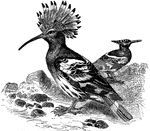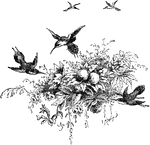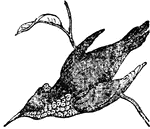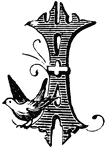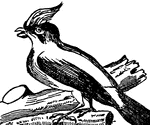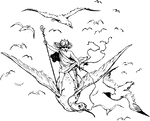
Heron
Herons are found on the edges of rivers, lakes and marshes and live on fishes, reptiles and sometimes…

Heron
Herons are found on the edges of rivers, lakes and marshes and live on fishes, reptiles and sometimes…

Heron
Herons are found on the edges of rivers, lakes and marshes and live on fishes, reptiles and sometimes…
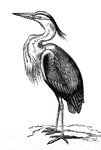
Heron
These wading birds mostly spend their time wading about in shallow water, feeding upon small fishes,…
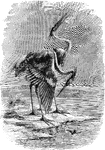
Heron
"Ardea. Great Herons. Of largest size, former well feathered all around. Tibia extensively denuded below.…

The Pelvis of a Heron
"Pelvis of a heron (ardea herodias), nat. size, viewed from below; from nature by Dr. R.W. Shufeldt,…
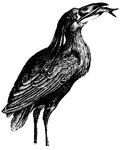
Boatbill Heron
This heron has a bill like an overturned boat. It also has a beautiful black crest that falls down behind…
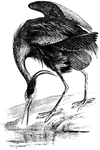
Great Blue Heron
"Ardea herodias. Great Blue Heron. Of large size, and varied dark colors, not dichromatic. Back without…
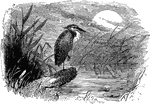
Night Heron
"Nyctiardea grisea naevia. Black-crowned Night Heron. Qua-bird. Squawk. Crown, scapulars and interscapulars…
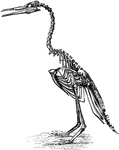
Restoration of Hesperornis regalis
"Hesperornis regalis, (a fossilized restoration) which stood about three feet high, had blunt teeth…
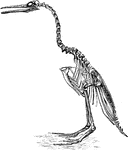
The Restoration of the Hesperornis Regalis
"Hesperornis regalis, (a fossilized restoration) which stood about three feet high, had blunt teeth…

Hoatzin
"The Hoatzin (Opisthocomus cristatus) is curious and highly specialized. "The body is long and thin,…

Hoopoe
The hoopoes are easily recognized from the double range of plumes which form an arched crest on their…

Hoopoe
"Upupa epops, not unfrequently visits Britain, where it has nested on several occasions; it breeds from…
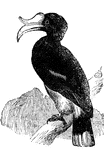
Hornbill
The hornbill family are remarkable for the very large size of the beak, and the large protuberance that…
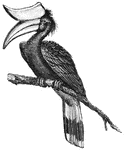
Hornbill
The hornbill family are remarkable for the very large size of the beak, and the large protuberance that…
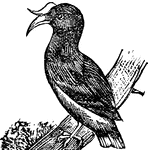
Hornbill
A large bird, found in Africa and Asia, having a large bill curved downward, on which is a process resembling…
!["They walk with difficulty and their flight is clumsy. [They are] native to Malaysia, India and Sumatra.](https://etc.usf.edu/clipart/51800/51896/51896_cc_hornbill_mth.gif)
Concave-Casqued Hornbill
"They walk with difficulty and their flight is clumsy. [They are] native to Malaysia, India and Sumatra.
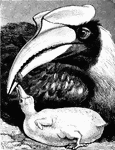
Female Hornbill Laying Down Feeding Her Young
"Dichoceros bicornis of India and the Malay countries has a large yellowish-red casque, hallowed and…

Plait-billed Hornbill
The Rytidoceros undulatus, Plait-billed Hornbill, or Wreathed Hornbill, has black wings, belly, and…
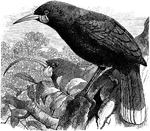
Huia
"Heteralocha acutirostris, the New Zealand Huia, the female has a remarkably long, curved bill, that…
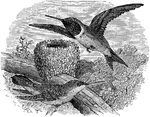
Ruby-throated Humming-bird
"Trochilus colubris. Ruby-throated Humming-bird. Tail forked, its feathers all narrow and pointed; no…
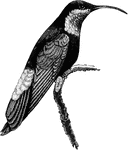
Hummingbird
"The Eulampis jugularis, or Hummingbird, has brilliant coloration almost defies description, the most…
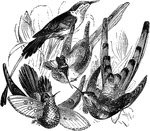
Hummingbird Species
Hummingbird species (Ornismya): Gould's hummingbird (O. gouldii), Bar-tailed hummingbird (O. sappho),…

Long Tailed Hummingbird
"Aithurus polytmus, the Long-tailed Hummingbird, peculiar to Jamaica, the two tail-feathers next to…

The Hyoid-bone of a Rook
"Hyoid bone; a, glosso-hyal, tipped with cartilage, its posterior horn being certo-hyals proper; b,…
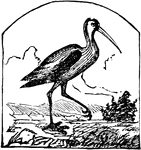
Ibis
A genus of wading birds, one species of which was regarded in ancient Egypt with a degree of respect…

Sacred Ibis
Wading birds with long, slender bills found in warmer climates of both hemispheres. The Sacred ibis…
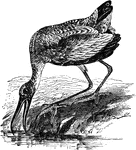
Wood Ibis
"Tantalops loculator. American Wood Stork. Wood Ibis. Colorado Turkey. Plumage white, the wing-quills,…

Skeleton Head of a Ichthyornis
"Ichthyornis victor and I. dispar, ...were small forms of about the size of a Partridge, with the habits…
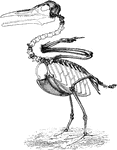
Restoration of Ichthyornis
"Ichthyornis, though the wings are well developed, with fused metacarpals, and the sternum is keeled,…
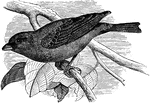
Indigo-bird
"Passerina cyanea. Indigo Painted Finch. Indigo-bird. Adult male: Indigo-blue, intense and constant…

Jacamar
Their habits are little known; but it is certain that they live isolated or in pairs, that they are…

Jacana
These birds have long toes and claws that permit them to walk easily across leaves of tropical aquatic…

Indian Jacana
"Hydrophasianus chirurgus, the Indian Jacana, of most of the Indian Region, is Bronzy-brown above and…
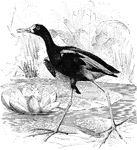
Parra Jacana
"Parra. Jacanas. Bill plover-like, contracted in continuity, enlarged terminally; with culmen depressed…

jackdaw
"Corvus monedul. Jackdaw. The species throughout uniform lustrous black, including the bill and feet;…

Blue Jay
Blue jays are abundant in the central and eastern states. They are characterized by blue-gray feathers…
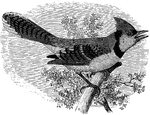
Blue Jay
"Cyanocitta cristata. Blue Jay. Male: Purplish-blue, below pale purplish-gray, whitening on throat,…

Canada Jay
"Perisoreus canadensis. Canada Jay. Whiskey Jack. Moose-bird. Gray whitening on head, neck, and breast;…
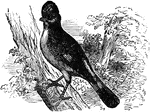
Eurasian Jay
"European Jay. Garrulus glandarius. With the wings much shorter than or about equalling the tail, both…

Long-crested Jay
"Cyanocitta stelleri macrolopha. Long-crested Jay. Upper parts sooty umber-brown, with a faint blue…

Joseph in Prison with the Cup-Bearer and the Chief Baker
"And Pharaoh was wroth against his two officers, against the chief of the butlers, and against the chief…
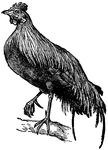
Jungle-fowl
Jungle-fowl is a general name given to the members of the genus Gallus. The red jungle-fowl, G. jerrugineus,…

Kagu
"Rhinochetus jubatus, the Kuga ... has powder-down patches that are profusely distributed over the whole…
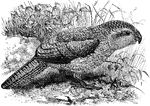
Kakapo
"Stringops habroptilus, the Kakapo or Tarapo of New Zealand has sap-green upper parts, with yellow middles…

Common Kestral
Falco tinnunculus. Common Kestral. This bird is a European bird of prey. Plumage on upperside, chestnut-brown…
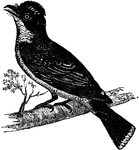
King-bird
Tyrannus carolinensis. King-bird. Bee-martin. No olive nor decided yellow. Only outer primaries obviously…
A Feather from the Tail of a Kingbird
"Fig. 23 - A feather from the tail of a kingbird, Tyrannus carolinensis, almost entirely pennaceous;…
